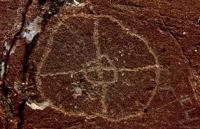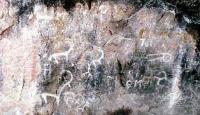You are here
Petroglyphs of Khodjakent.


Mountain hiking in Western Tien-Shan.
“No century can write its own story”
Spencer G.
Art-crawl on city Uzbekistan.
Khodjakent, one of the famous Uzbekistan rock art sites, is located on the western slope of the Chatkal Range on the left bank of the Chirchik River 70km north-east of Tashkent. In 1949 - 1950, Kazakh archeologist Kh.
Alpysbaev discovered and registered 23 images of goats, horses, people and unidentified signs that he dated to the Ist century BC in the upper reaches of the Chirchik River on the south-eastern slope of the Korzhantau Mountains near the Khodjakent settlement (Alpysbaev 1956: 188).
The research on the site was continued in 1980 by M.M. Khujanazarov (Khujanazarov 1995: 173). Petroglyphs are carved on a vertical limestone rock 12.5 m high and 18 m wide. The rock surface faces north-west towards the river.
The images are predominantly arranged in the lower part of the Rock Art in Central Asia 108 rock at human height. A total of more than 90 were registered, mostly mountain goats, arkhars, deer, horses, oxen, dogs, and unidentified signs; anthropomorphs occur frequently.
Three female figures depicted head-on are of special interest. Small indentations indicate sexual organs. The figures have no arms or heads and only the last one has a hand. They are partially superimposed by goats, an anthropomorph and an animal (horse?).
No similarities have been found in Middle Asia and Kazakhstan. The technique of carving for most petroglyphs in Khodjikent is similar: an outline was marked first and then the entire figure was carved. The surface of most images is smooth.
The drawings differ in depth: from 0.5mm to 20.0mm. The surface of superficially-carved images is more weathered and barely distinguishable from the rock surface. The repertoire, style, technique, status of preservation and stratigraphic location of the most ancient Khodjakent petroglyphs (primarily, images of women) date them to the Eneolithic, i.e. from the 4th to the first half of the IInd millennium BC.
The remaining drawings are mainly dated to the Saka Period.
The Khodjakent rock art is on the State List of Cultural Sites of Local Importance and has been put on Uzbekistan’s Tentative World Heritage List.
Authority:
Muhiddin Khujanazarov.
Photos by
Alexander Petrov.







